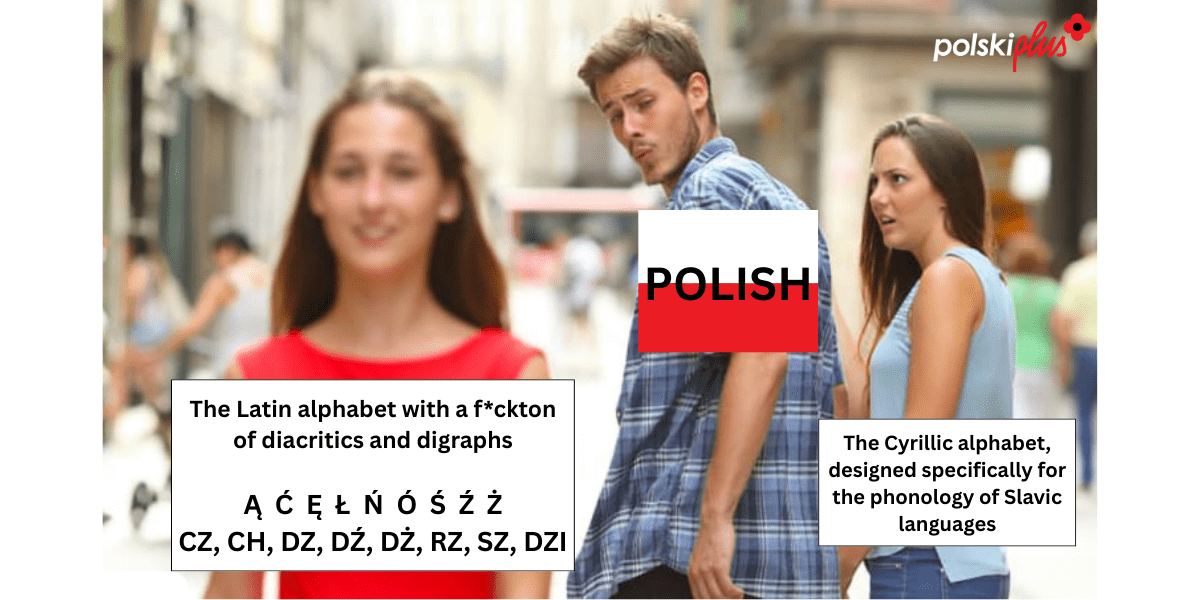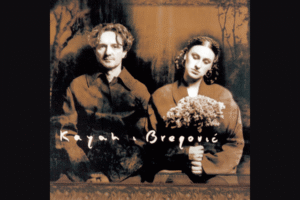
A Short History of Polish Alphabet
Polish language belongs to the Slavic language family. Particularly for those languages and their specific pronunciation, in the 9th century a Thessalonian monk – Saint Ciril, created the first Slavic alphabet- Glagolitic script. This style of writing became a base for Cyrillic script which is nowadays with modifications widely used by several Slavic languages like Russian, Belarusian or Bulgarian. There are a couple of Slavic languages though (including Polish, but also Czech or Croatian) which decided to go a separate path and chose not to use Glagolitic, even though it was specially created for their specific phonetic needs.
Table of Contents
To understand the reason for such a situation, which at the first glance seems very irrational, we need to go back more than 1000 years and take a deeper look at the history of the Polish alphabet.

Beginnings
The Polish alphabet started to develop in the XII century, which is quite late compared with other European countries. The first written Polish sentence was: Day, ut ia pobrusa, a ti poziwai and it didn’t look at all like written in modern Polish. If we would like to note it using contemporary letters and rules it would look more like: Daj, niech ja pomielę, a ty odpoczywaj (Let me grind and you rest– it was a sentence spoken by a husband to his working wife). The Middle Ages version was very similar to Latin, as, in the first attempts at writing in Polish, the Latin alphabet was used. It looked weird and probably sounded even weirder as Latin letters were not able to reflect all Polish sounds. Coming to the point where the Polish alphabet is capable of expressing all sounds from our language took many centuries and was a rather harsh process of adjusting its Latin role model.
Why Latin and not a Cyrillic script?
Here we come to the main point illustrated in the funny picture used as a cover for this article. Why? What is the purpose of going through so much trouble with adjusting the alphabet from a different and distant language as Latin, while almost next door, the eastern neighbors had nearly perfectly fitted Slavic alphabet with sounds very similar to Polish ones? The answer to this question lies centuries back and it’s a result of a bold decision of Polish prince Mieszko I taken in the year 966. Mieszko decided to abandon Paganism and convert himself and as a result all land he has under his jurisdiction to Christianity.
What is important Christianity was “taken from” neighboring Czechia and spread by Roman Catholic Church. This event called “Baptism of Poland ” actually shaped the future of Poland and had a major impact on all spheres of life, starting with politics and ending on culture and lifestyle. As mentioned, it was important from which source Christianity expanded on Polish land. Spreading Christianity through Czechia from Rome placed Poland in a western sphere of Roman and Catholic influences. If Christianity would come from Constantinople we would probably now write in Cyrillic script and we have not Catholic but Orthodox churches dominant in the Polish landscape.

Baptism of Poland and its Consequences
Up to nowadays, it is still uncertain why Mieszko decided to convert. Most popular theories mark his reasons as political- baptism was one of the conditions of the Polish-Czechia alliance which was important to Mieszko due to military reasons. But there is also one more romantic theory claiming that Mieszko decided to baptize as a result of the influence of his Czech wife- Dobrawa who was a devoted Christian woman. Whatever the reason was, Mieszko changed history. Since that time it has become quite obvious that Poland, now under Catholic influence, will go on a different path than their Eastern Slavic neighboring countries, which belonged to the Orthodox church sphere of impact.
Additionally, writing and books were in the Middle Ages reserved almost entirely for the church. All of the above resulted in the fact that the Polish alphabet was built on Latin script rather than Cyrillic (take a look at the Polish word ksiądz– priest, and książka– book, it is quite obvious who was writing and reading books at that time).
Evolution of Polish Alphabet
As stated before, the development of the Polish alphabet was not an easy process. It can be simply described in one word – chaos. As the Latin alphabet was not adjusted to Polish sounds, every writer was using different tricks and ways trying to best mimic Polish sounds.
Up top XV one letter could reflect a couple of sounds for example c was standing for c, cz, and k. Ą and ę didn’t exist yet, so the nasal sounds were represented by am, an, e, em, en, o, um, un and ø. It was a bit later when nasal sounds started to be represented by ę (e+nasal) and ą (nasal a didn’t survive till our times, but the letter remained as a representation of nasal o).
In the XVI century many attempts were made to bring some structure into this disorder. Many sounds, till that time confused and misused, got their separate representation, for example ł,s,ś,sz,c,ć, cz, z, ź and ż. During this periodj didn’t exist – it was written asi or y, and there was a letter x which was pronounced as ks. What is interesting, is that time Polish had much more vowels than nowadays. Except for standard a,e and o, there were ȧ, ė, ȯ – so-called inclined vowels. They didn’t last till our time. In the XVIII century, ȧ and ė disappeared. Only ȯ survived, however over time it changed its pronunciation and is now being articulated the same as u. At that time also letter j appeared. Ch and h were pronounced differently, ch was voiceless, and h was voiced.
Now they are pronounced the same in standard Polish but the difference in pronunciation still exists in some dialects and in border areas where Polish and other Slavic languages interfere- near the eastern and southern border. What is interesting, is that differentiation in standard language didn’t disappear centuries ago, that’s quite a new process that happened within the last century.

Today Polish alphabet consists of 32 letters: 8 vowels (a,e,i,o.u/ó,y and nasal ą, ę) and 23 consonants (4 which we can call soft ć,ś,ń,ź, 1 hard ż) We currently don’t have x,v or q (they can appear in foreign words like for example quiz), but we have one consonant that is specific almost only for Polish – letter ł.
The Cyrillic script, takes two
In the middle of the XIX century Russian emperor Nicholas I tried to implement a Cyrillic script in the area of the Kingdom of Poland (back ten that was a semi-autonomous Polish state created on the part of the land of current Poland). The attempt was not successful due to too many obstacles, among others linguistic and political. This version of Polish Cyrillic contains 46 letters and can be viewed here Polish Alphabet Cyrillic
What will the future bring?
Nowadays quite often we may hear opinions that the simplification of Polish writing and as a consequence, its alphabet is needed. A most common postulate is to conciliate letters that sound the same (ó=u, rz=ż, ch=h). As is claimed by supporters of this idea, there is no value added to keeping multiple letters that produce the same sound. More harsh ideas are even considering getting rid of all letters with diacritics (ś,ć, ź,ń) and nasal vowels ą and ę (precisely to replace them with the connection of “normal letters”- for example om and em). As such ideas would bring quite a few advantages – Polish would be easier not only for native speakers but also for foreigners, but for now, it is really unlikely to happen. Here are a couple of reasons why.
Let’s start with an argument related to tradition and historical heritage. The way we write tells our story as a nation and particular letters, even if outdated or complicated, carry great historical knowledge about the language and its development. Secondly, such change may complicate things rather than simplify them. Unifying ó/u ch/h and ż/rz may cause problems in distinguishing words (for example morze/może), but getting rid of diacritics and nasal sounds will make understanding words a lot harder. Also, from a practical point of view, it is almost impossible- such change would generate tremendous costs and chaos, generating the need to rewrite all books and change the complete system of learning Polish.
Lastly, the majority of linguists are committed to the opinion that the beauty of language lies in its natural development, free from artificial inference. Of course for each of these arguments, there will be counterarguments coming from supporters of simplifying orthography. They are responding that there won’t be many words that will suffer from unifying ó/u, ż/rz, ch/h – as we already have so many exceptions in Polish, we may have few more; in many situations, Polish diacritics are already not being used for example in e-mails and SMS-es and somehow we can understand each other, lastly many countries decided to simplify or reform their linguistics systems and their languages didn’t lose much of their beauty.
That is a never-ending discussion that continues for many years. Times go by but no modification seems to be in sight. Polish is deeply anchored in its tradition and any changes are rather hard to implement. Reach out to us to know more about Polish courses online
Source of ilustrations:https://twojahistoria.pl/; https://www.theguardian.com/ photograph Minna Sundberg




1 Comment